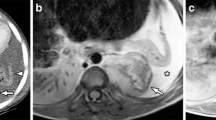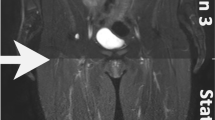Abstract
MRI offers an alternative to CT, and thus is central to an ALARA strategy. However, long exam times, limited magnet availability, and motion artifacts are barriers to expanded use of MRI. This article reviews developments in pediatric body MRI that might reduce these barriers: high field systems, acceleration, navigation and newer contrast agents.




Similar content being viewed by others
References
Edelstein WA, Glover GH, Hardy CJ et al (1986) The intrinsic signal-to-noise ratio in NMR imaging. Magn Reson Med 3:604–618
Gold GE, Han E, Stainsby J et al (2004) Musculoskeletal MRI at 3.0 T: relaxation times and image contrast. AJR 183:343–351
Schindera ST, Merkle EM, Dale BM et al (2006) Abdominal magnetic resonance imaging at 3.0 T: what is the ultimate gain in signal-to-noise ratio? Acad Radiol 13:1236–1243
Hardy CJ, Darrow RD, Saranathan M et al (2004) Large field-of-view real-time MRI with a 32-channel system. Magn Reson Med 52:878–884
Soher BJ, Dale BM, Merkle EM (2007) A review of MR physics: 3 T versus 1.5 T. Magn Reson Imaging Clin N Am 15:277–290
Zhu Y, Hardy CJ, Sodickson DK et al (2004) Highly parallel volumetric imaging with a 32-element RF coil array. Magn Reson Med 52:869–877
Erberich SG, Friedlich P, Seri I et al (2003) Functional MRI in neonates using neonatal head coil and MR compatible incubator. Neuroimage 20:683–692
Bolog N, Nanz D, Weishaupt D (2006) Muskuloskeletal MR imaging at 3.0 T: current status and future perspectives. Eur Radiol 16:1298–1307
O'Regan DP, Fitzgerald J, Allsop J et al (2005) A comparison of MR cholangiopancreatography at 1.5 and 3.0 tesla. Br J Radiol 78:894–898
Chung T, Muthupillai R (2004) Application of SENSE in clinical pediatric body MR imaging. Top Magn Reson Imaging 15:187–196
Vasanawala SS, Alley MT, Hargreaves BA et al (2010) Improved pediatric MR imaging with compressed sensing. Radiology 256:607–616
Lustig M, Donoho D, Pauly JM (2007) Sparse MRI: the application of compressed sensing for rapid MR imaging. Magn Reson Med 58:1182–1195
White LM, Buckwalter KA (2002) Technical considerations: CT and MR imaging in the postoperative orthopedic patient. Semin Musculoskelet Radiol 6:5–17
Busse RF, Hariharan H, Vu A et al (2006) Fast spin echo sequences with very long echo trains: design of variable refocusing flip angle schedules and generation of clinical T2 contrast. Magn Reson Med 55:1030–1037
Lebel RM, Wilman AH (2007) Intuitive design guidelines for fast spin echo imaging with variable flip angle echo trains. Magn Reson Med 57:972–975
Hennig J, Weigel M, Scheffler K (2003) Multiecho sequences with variable refocusing flip angles: optimization of signal behavior using smooth transitions between pseudo steady states (TRAPS). Magn Reson Med 49:527–535
Alsop DC (1997) The sensitivity of low flip angle RARE imaging. Magn Reson Med 37:176–184
Mugler JP, Kiefer B, Brookeman JR (2000) Three-dimensional T2-weighted imaging of the brain using very long spin-echo trains. International Society of Magnetic Resonance in Medicine 8th Meeting, Denver, CO, p 687
Ehman RL, Felmlee JP (1989) Adaptive technique for high-definition MR imaging of moving structures. Radiology 173:255–263
Sachs TS, Meyer CH, Hu BS et al (1994) Real-time motion detection in spiral MRI using navigators. Magn Reson Med 32:639–645
Wang Y, Rossman PJ, Grimm RC et al (1996) Navigator-echo-based real-time respiratory gating and triggering for reduction of respiration effects in three-dimensional coronary MR angiography. Radiology 198:55–60
Huang J, Raman SS, Vuong N et al (2005) Utility of breath-hold fast-recovery fast spin-echo T2 versus respiratory-triggered fast spin-echo T2 in clinical hepatic imaging. AJR 184:842–846
Kim BS, Kim JH, Choi GM et al (2008) Comparison of three free-breathing T2-weighted MRI sequences in the evaluation of focal liver lesions. AJR 190:W19–W27
Klessen C, Asbach P, Kroencke TJ et al (2005) Magnetic resonance imaging of the upper abdomen using a free-breathing T2-weighted turbo spin echo sequence with navigator triggered prospective acquisition correction. J Magn Reson Imaging 21:576–582
Lee SS, Byun JH, Hong HS et al (2007) Image quality and focal lesion detection on T2-weighted MR imaging of the liver: comparison of two high-resolution free-breathing imaging techniques with two breath-hold imaging techniques. J Magn Reson Imaging 26:323–330
Vasanawala SS, Iwadate Y, Church DG et al (2010) Navigated abdominal T1-W MRI permits free-breathing image acquisition with less motion artifact. Pediatr Radiol 40:340–344
Bluemke DA, Sahani D, Amendola M et al (2005) Efficacy and safety of MR imaging with liver-specific contrast agent: U.S. multicenter phase III study. Radiology 237:89–98
Jung G, Breuer J, Poll LW et al (2006) Imaging characteristics of hepatocellular carcinoma using the hepatobiliary contrast agent Gd-EOB-DTPA. Acta Radiol 47:15–23
Grist TM, Korosec FR, Peters DC et al (1998) Steady-state and dynamic MR angiography with MS-325: initial experience in humans. Radiology 207:539–544
Lauffer RB, Parmelee DJ, Ouellet HS et al (1996) MS-325: a small-molecule vascular imaging agent for magnetic resonance imaging. Acad Radiol 3(Suppl 2):S356–S358
Lin W, Abendschein DR, Haacke EM (1997) Contrast-enhanced magnetic resonance angiography of carotid arterial wall in pigs. J Magn Reson Imaging 7:183–190
Prompona M, Cyran C, Nikolaou K et al (2009) Contrast-enhanced whole-heart MR coronary angiography at 3.0 T using the intravascular contrast agent gadofosveset. Invest Radiol 44:369–374
Stuber M, Botnar RM, Danias PG et al (1999) Contrast agent-enhanced, free-breathing, three-dimensional coronary magnetic resonance angiography. J Magn Reson Imaging 10:790–799
Wagner M, Rief M, Asbach P et al (2010) Gadofosveset trisodium-enhanced magnetic resonance angiography of the left atrium—a feasibility study. Eur J Radiol 75:166–172
(2004) Gadofosveset: MS 325, MS 32520, Vasovist, ZK 236018. Drugs R D 5:339–342
Disclaimer
The supplement this article is part of is not sponsored by the industry. Dr. Vasanawala and Dr. Lustig have no financial interests. Dr. Vasanawala discusses commercial products/services.
Author information
Authors and Affiliations
Corresponding author
Rights and permissions
About this article
Cite this article
Vasanawala, S.S., Lustig, M. Advances in pediatric body MRI. Pediatr Radiol 41 (Suppl 2), 549 (2011). https://doi.org/10.1007/s00247-011-2103-6
Received:
Revised:
Accepted:
Published:
DOI: https://doi.org/10.1007/s00247-011-2103-6




